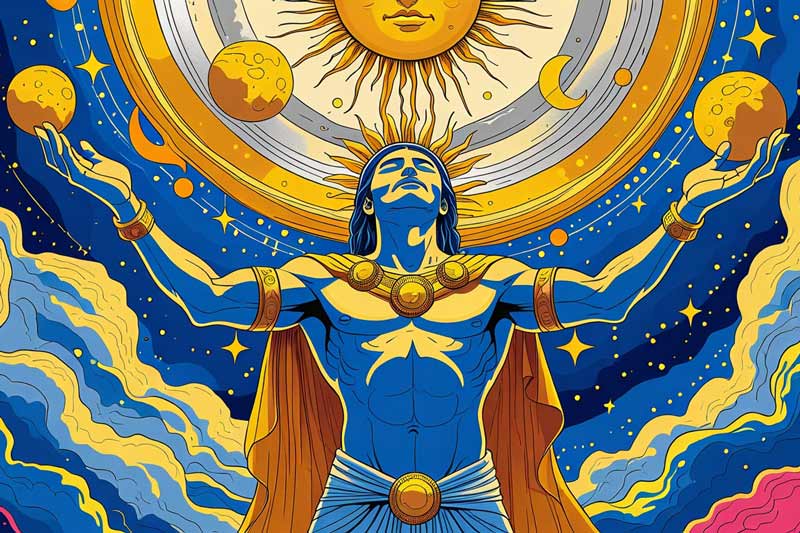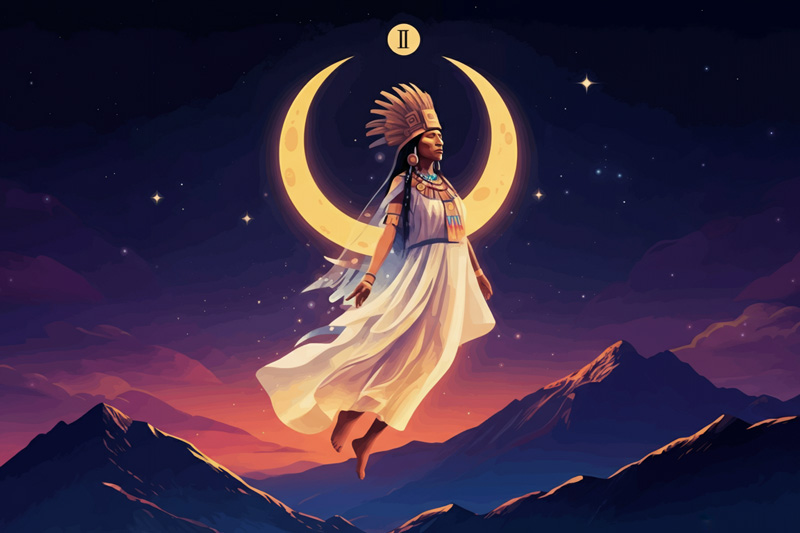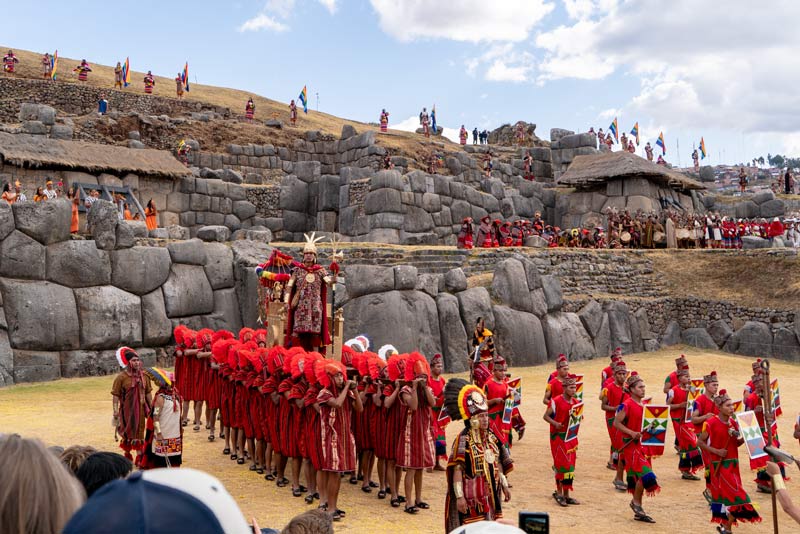What was the Inca religion?
The Inca culture is one of the most enigmatic in the world. Full of mysteries, one of the main ones that attracts the most questions is about their religion. The Incas were polytheistic, meaning they worshipped many gods. Learn who these deities were and the reason for their importance within the Inca worldview.
- The religion of the Incas
- Who were the main deities for the Incas?
- Recommendations for your visit to the Temples of the Inca Gods
- Questions and answers about the religion of the Incas
The religion of the Incas
Within a culture, religion always plays a leading role, attempting to provide meaning to its inhabitants. Finding ourselves in a world lacking answers, doubts always overwhelmed us. This was not uncommon in the Incan culture, which was polytheistic, attributing reason to beings who, unlike other religions, were tangible or real, as was the case with many animals, nature itself, and even the sun and moon.
Prior to the Inca culture, no main god was worshipped; instead, each people or individual assigned the reason for life and existential questions to their own gods or reasons. Everything changed when the Inca Empire established power and elevated the sun god (Inti) as the principal entity, but without neglecting the other deities that each individual possessed.
Are you intrigued by the reasons why the Incas worshipped their gods?
Discover the temples, monuments, and cities built in honor of their deities. Explore Machu Picchu by discovering the Temple of the Moon and the Temple of the Condor; also, visit Qoricancha and discover the Temple in honor of the Sun. Each of the Inca cities is steeped in mystery and reasons governed by mysticism. Learn about each one through Boletomachupicchu and be amazed by the Inca culture.
Who were the main deities for the Incas?
Within the Inca religion, many gods were worshipped, most of which were justified by their role in nature and their influence on the daily activities of the entire Tahuantinsuyu empire. Discover who the most important ones were:
The Sun God (Inti)
The most representative and venerated deity of Inca culture was the sun god, who was regarded as the father of the Inca (the Inca was considered a descendant of the sun) and to whom the prosperity of the Tahuantinsuyu was attributed. The reason for his worship went beyond the mystical; it also gained meaning in terms of the development and productivity of the land, as it was directly related to agriculture and crop growth.
A culture is considered powerful by the courage of its people, as well as the wealth of its lands. In the case of the Incas, both situations were directly related to the influence that the Sun God had on them and their lands.
A reflection of how important the Sun was to them is the Inti Raymi festival , a festivity that brought together the entire Tahuantinsuyo and celebrated the winter solstice, a time when homage and tribute were paid to the Sun for all the prosperity it brought throughout the season.
Places and temples in his honor can be found in the Qoricancha in Cusco, the Temple of the Sun in Machu Picchu , also in the fortress of Ollantaytambo and the archaeological center of Pisac.
The God Viracocha
The creator of everything in the Inca culture, and many cultures before it, was called Viracocha (also known as Wiracocha or Huiracocha), who shaped everything that existed, such as the Sun, the Moon, the stars, and even people themselves.
It was believed that the god Viracocha had provided all the knowledge their culture possessed, teaching them art, agriculture, and even social organization. It is also often said that he then departed, walking on water in the promise of his return.
This being was depicted as a very hairy, long-lived creature wearing a long tunic. In many of the images created in his honor, he is seen carrying scepters or staffs, which symbolized the power he possessed. Definitely one of the most mysterious beings in all of Inca culture .

Graphic representation of Viracocha
Mother Earth (Pachamama)
Pachamama’s value in Inca culture was one of the most transcendent, as she was venerated as the goddess of fertility, the earth, and agriculture. These aspects kept the entire Tahuantinsuyu prosperous.
To this day, in Andean culture, and in many others, there is a veneration of Mother Earth, beyond her mystical aspect, given that she is the one who provides fertility to nature and the land, essential for daily subsistence.
Constant gratitude, an attitude of humility toward the earth, even small tributes like pouring a little of your drink onto the ground, keep the belief in Pachamama alive, even more so today, when the value of preservation and the balance between receiving and giving have been lost.
There are other rituals very present in her honor, such as the tribute to the earth, where people give her many offerings such as leaves, chicha, and food, to maintain a balance for the protection and fertility she provides.
One of the possible places where the veneration of this goddess could have taken place was at the site of Moray, where circular terraces were used to experiment with agriculture.
The Moon Goddess (Mama Quilla)
In Inca beliefs, Mama Quilla was the partner of the Sun God (Inti) and served as a symbol of the mother of the entire empire. Worship of this goddess was also linked to time and the lunar cycle, which depended on her to ensure that the seasons did not change significantly.
She was also highly venerated by the women of the Tahuantinsuyo, given that Mama Quilla was the entity that they believed protected them, especially in matters of relationships or unions with partners and the fertility that these might possess.
Its representation is visualized as a silver disc. Its temples can be visited in Machu Picchu and also in areas near Cusco. They are places of great energy and mysticism, where you seem to find answers without the need for words.

Graphic representation of Mama Quilla
The God of Lightning and Storms (Illapa)
In Inca culture, Illapa was one of the most important gods, representing Lightning and Storm, fundamental for creating rain, which is essential for the fertility of the lands and the prosperity of a strong empire.
In the Inca worldview it was believed that the god Illapa carried with him a sling and a Kero (ceremonial vessel) filled with water, and that when he shook his sling it produced thunder, letting rain fall on the earth.
In times of drought, the Incas worshipped it by making pilgrimages from temples located on high mountains, such as the temple of Huanacaure, where you can still see it today to understand its grandeur and the value of poetry.
The Goddess of Water (Mama Cocha)
The deity Mama Cocha was seen as a representation of lakes, rivers, seas, and springs. Her name means “mother of water,” having a more direct relationship with the protection of life in the waters and their navigators.
Her veneration along the coasts was more prevalent, and she was depicted as a woman with wavy hair that flowed like water. She was also associated with providing marine food and life through the water currents.
In Inca legends, the deity Mama Cocha lived with the purest people and taught them to live in balance, with peace and love. She was intended to be a reflection of an ideal world. These values were closely linked to the use of water, which played a major role in the construction of Inca temples and cities, still visible today.
Main Inca Gods
| God | Description | Places of worship |
|---|---|---|
| Viracocha | Creator God, creator of the universe and humanity. | Mythical sites in Cusco, its cult spread throughout the Andean worldview, although it does not have a single temple. |
| Inti | Sun God, father of the Inca and central figure in the Inca religion. | Coricancha (Cusco), Intihuatana (Machu Picchu), temples of the Sun in Pisac and Ollantaytambo. |
| Mama Quilla | Moon Goddess, protector of women, responsible for the lunar cycle and fertility. | Temple of the Moon (Cusco) and Moon Island (Lake Titicaca, Bolivia). |
| Pachamama | Mother Earth, goddess of the earth, nature, and agriculture, to whom offerings are still made in rituals today. | Ritual sites such as Moray and Laguna de Urcos (both in Cusco) and numerous altars in Andean communities. |
| Illapa | God of lightning, storms and rain, invoked to bring fertility to the lands. | Huanacaure Temple (Cusco) and other sanctuaries in sacred mountain areas. |
| Mama Cocha | Goddess of water, protector of lakes, rivers and seas, vital to fishing communities. | Sanctuaries and altars in coastal communities of Peru and other Andean areas, their worship has been maintained in fishing areas. |
Recommendations for your visit to the Temples of the Inca Gods
- Visit Machu Picchu to see the Temple of the Moon, the Temple of the Condor, and the Intihuatana. The energetic connection these sites provide will make your visit unforgettable.
- Keep an open mind when listening to stories about Incan religion and beliefs; everyone has their own way of seeing the world and trying to understand it.
- Having a sensitive attitude when visiting the main temples dedicated to the Inca deities will allow you to feel ancestral energy that seems to whisper their history to you.
- Take advantage of the opportunity to take a break from your routine and reflect amidst beautiful landscapes.
- Immerse yourself in Inca culture by learning and exploring why the Incas built such magnificent buildings and temples.
- Keep a notebook to write down your experiences, so you don’t miss a single detail and make these trips last forever.
- Remember to stop and take in the buildings and nature in their entirety to feel more immersed in your visit.
- You can plan a tour visiting the main ceremonial centers and temples honoring the gods. Consult with our advisors and discover the magic that awaits you throughout Cusco.
Questions and answers about the religion of the Incas
1) What was the religion of the Incas?
The Inca religion was polytheistic, meaning they worshipped multiple gods. Their main god was the Sun (Inti).
2) What does it mean that the Incas were polytheists?
Being polytheistic involves worshipping various deities, each representing essential aspects of life and nature, such as the sun, the moon, the earth, and natural phenomena such as lightning and water.
3) Who were the main deities for the Incas?
The main deities were:
- Inti (Sun God): Central figure and father of the Inca, essential for agriculture and prosperity.
- Viracocha: The creator god, responsible for the creation of the universe and knowledge.
- Pachamama (Mother Earth): Goddess of fertility, earth and agriculture.
- Mama Quilla (Moon Goddess): Protector of women and regulator of the lunar cycle.
- Illapa (God of Lightning and Storm): In charge of rain and the fertility of the lands.
- Mama Cocha (Goddess of Water): Protector of lakes, rivers and seas, vital for life on the coasts.
4) Why was the god Inti (Sun) so important in the Inca culture?
Inti (Sun) was considered the father of the Inca and the source of prosperity, since his direct influence on agriculture ensured the productivity of the land.
5) Who was the god Viracocha in Inca mythology?
Viracocha was the creator god who shaped the universe: he created the sun, the moon, the stars, and even people. He is also credited with transmitting essential knowledge about art, agriculture, and social organization, marking a turning point in the Inca worldview.
6) What is the relevance of Pachamama in the Inca culture?
Pachamama is venerated as Mother Earth and goddess of fertility and agriculture. Her worship is still alive and is expressed in rituals of offerings and gratitude to the earth, essential practices for maintaining balance and daily subsistence in Andean communities.
7) What does the goddess Mama Quilla symbolize in the Inca culture?
Mama Quilla, the goddess of the moon, symbolizes the protection of women and regulates the lunar cycle, which influences seasons and fertility.
8) How did religion influence the social and political organization of the Inca Empire?
Religion was the backbone of the Inca state. The Inca considered himself a direct descendant of the sun god (Inti). Furthermore, the hierarchical structure of society was reflected in temples and rituals, reinforcing the power of the ruling elite through mysticism and belief in the divine.
9) How has the influence of the Inca religion endured in today’s Andean communities?
Although the arrival of the Spanish brought with it the imposition of Christianity, many Andean communities have preserved ancestral traditions. Rituals of offerings to Pachamama, solstice celebrations, and festivities that merge indigenous and Christian beliefs are living examples of how the Inca worldview remains present in everyday life.
Advice from people who have been there
 By: Morgan R.
By: Morgan R.“Temple of the Moon in Machu Picchu“
“My visit to the Temple of the Moon was full of magic and energy. Since we were a short distance away I could feel that I was in a sacred place. I had time to relax and contemplate it completely, it gave me a lot of calm and satisfaction. Highly recommended for your visit to Machu Picchu.“
By Ticket Machu Picchu – Last updated, April 4, 2025

